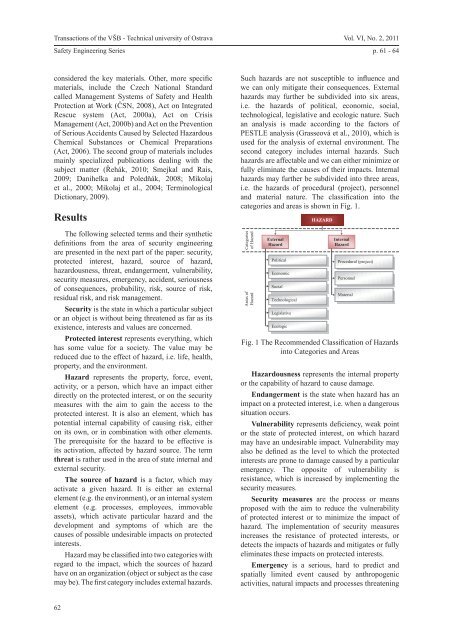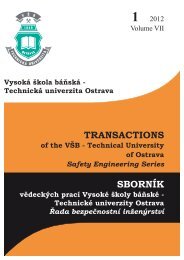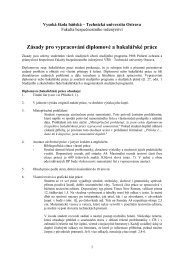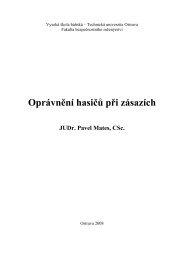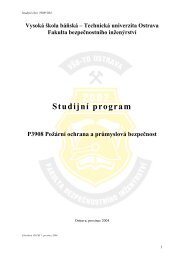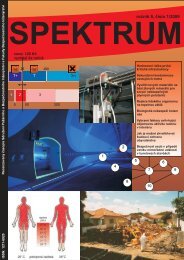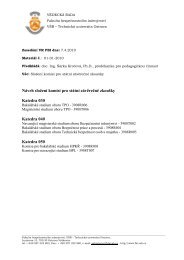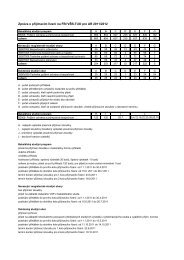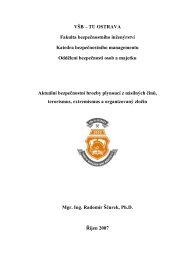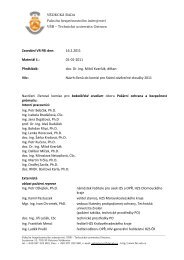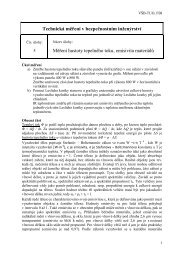Transactions - FBI - Vysoká Å¡kola báÅská - Technická univerzita ...
Transactions - FBI - Vysoká Å¡kola báÅská - Technická univerzita ...
Transactions - FBI - Vysoká Å¡kola báÅská - Technická univerzita ...
Create successful ePaper yourself
Turn your PDF publications into a flip-book with our unique Google optimized e-Paper software.
<strong>Transactions</strong> of the VŠB - Technical university of OstravaSafety Engineering SeriesVol. VI, No. 2, 2011p. 61 - 64considered the key materials. Other, more specificmaterials, include the Czech National Standardcalled Management Systems of Safety and HealthProtection at Work (ČSN, 2008), Act on IntegratedRescue system (Act, 2000a), Act on CrisisManagement (Act, 2000b) and Act on the Preventionof Serious Accidents Caused by Selected HazardousChemical Substances or Chemical Preparations(Act, 2006). The second group of materials includesmainly specialized publications dealing with thesubject matter (Řehák, 2010; Smejkal and Rais,2009; Danihelka and Poledňák, 2008; Mikolajet al., 2000; Mikolaj et al., 2004; TerminologicalDictionary, 2009).ResultsThe following selected terms and their syntheticdefinitions from the area of security engineeringare presented in the next part of the paper: security,protected interest, hazard, source of hazard,hazardousness, threat, endangerment, vulnerability,security measures, emergency, accident, seriousnessof consequences, probability, risk, source of risk,residual risk, and risk management.Security is the state in which a particular subjector an object is without being threatened as far as itsexistence, interests and values are concerned.Protected interest represents everything, whichhas some value for a society. The value may bereduced due to the effect of hazard, i.e. life, health,property, and the environment.Hazard represents the property, force, event,activity, or a person, which have an impact eitherdirectly on the protected interest, or on the securitymeasures with the aim to gain the access to theprotected interest. It is also an element, which haspotential internal capability of causing risk, eitheron its own, or in combination with other elements.The prerequisite for the hazard to be effective isits activation, affected by hazard source. The termthreat is rather used in the area of state internal andexternal security.The source of hazard is a factor, which mayactivate a given hazard. It is either an externalelement (e.g. the environment), or an internal systemelement (e.g. processes, employees, immovableassets), which activate particular hazard and thedevelopment and symptoms of which are thecauses of possible undesirable impacts on protectedinterests.Hazard may be classified into two categories withregard to the impact, which the sources of hazardhave on an organization (object or subject as the casemay be). The first category includes external hazards.Such hazards are not susceptible to influence andwe can only mitigate their consequences. Externalhazards may further be subdivided into six areas,i.e. the hazards of political, economic, social,technological, legislative and ecologic nature. Suchan analysis is made according to the factors ofPESTLE analysis (Grasseová et al., 2010), which isused for the analysis of external environment. Thesecond category includes internal hazards. Suchhazards are affectable and we can either minimize orfully eliminate the causes of their impacts. Internalhazards may further be subdivided into three areas,i.e. the hazards of procedural (project), personneland material nature. The classification into thecategories and areas is shown in Fig. 1.Categoriesof HazardAreas ofHazardExternalHazardPoliticalEconomicSocialTechnologicalLegislativeEcologicHAZARDInternalHazardProcedural (project)PersonnelMaterialFig. 1 The Recommended Classification of Hazardsinto Categories and AreasHazardousness represents the internal propertyor the capability of hazard to cause damage.Endangerment is the state when hazard has animpact on a protected interest, i.e. when a dangeroussituation occurs.Vulnerability represents deficiency, weak pointor the state of protected interest, on which hazardmay have an undesirable impact. Vulnerability mayalso be defined as the level to which the protectedinterests are prone to damage caused by a particularemergency. The opposite of vulnerability isresistance, which is increased by implementing thesecurity measures.Security measures are the process or meansproposed with the aim to reduce the vulnerabilityof protected interest or to minimize the impact ofhazard. The implementation of security measuresincreases the resistance of protected interests, ordetects the impacts of hazards and mitigates or fullyeliminates these impacts on protected interests.Emergency is a serious, hard to predict andspatially limited event caused by anthropogenicactivities, natural impacts and processes threatening62


